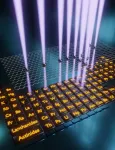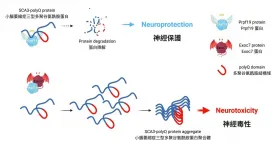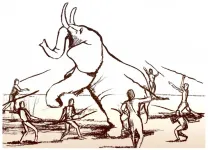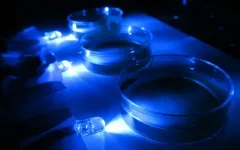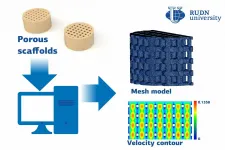Searching for novel targets for new antibiotics
Helper protein controls interactive process of ribosome formation
2021-03-01
(Press-News.org) Ribosome formation is viewed as a promising potential target for new antibacterial agents. Researchers from Charité - Universitätsmedizin Berlin have gained new insights into this multifaceted process. The formation of ribosomal components involves multiple helper proteins which, much like instruments in an orchestra, interact in a coordinated way. One of these helper proteins - protein ObgE - acts as the conductor, guiding the entire process. The research, which produced the first-ever image-based reconstruction of this process, has been published in Molecular Cell*.
Ribosomes are an essential component of all living cells. Frequently referred to as 'molecular protein factories', they translate genetic information into chains of linked-up amino acids which are otherwise known as proteins. The process of protein biosynthesis is the same in all cells, even in bacteria (including the widely known intestinal bacterium Escherichia coli). If this process cannot take place, the cell dies; single-celled organism (such as E. coli and other bacteria) cannot survive. Researchers are hoping to exploit this circumstance for the development of novel antibiotic agents. The need for these new drugs is not only the result of an increase in antibiotic resistance and the emergence and spread of new multidrug-resistant pathogens, but also because it has been a long time since a new class of antibiotic substances emerged. A new type of antibiotic might be designed to interfere with ribosome formation in a way that inhibits their assembly.
"It is a coincidence that we are currently in the middle of a viral pandemic. The next pandemic could easily be of bacterial origin because both bacterial antibiotic resistance and multidrug resistance are spreading rapidly, across species barriers", explains the study's last author, Prof. Dr. Christian Spahn, Director of Charité's Institute of Medical Physics and Biophysics. He adds: "The long-term aim of our basic research is therefore to contribute to the development of new antibiotics." Working with colleagues from the Max Delbrück Center for Molecular Medicine MDC) in Berlin and the University of Konstanz, the Charité researchers explored the early stages of ribosome formation to identify points in the process which might serve as targets for new antibacterial and antimicrobial drugs.
Ribosomes consist of two subunits: one larger subunit and one smaller one. As part of their latest endeavors, the team, led by Dr. Rainer Nikolay of Charité's Institute for Medical Physics and Biophysics, focused on studying the nature and development of the larger ribosomal subunit in the bacterium E.coli. Hoping to identify a potential target for new antibiotics, the researchers wanted to isolate and visualize the precursor stages of this larger subunit. To do so, they wanted to use the subunit in its unadulterated form, i.e. as close to its natural condition as possible. For the first time, the researchers succeeded in not only isolating one such precursor from bacterial cells (in this case, E. coli), but also visualizing it using cryo-electron microscopy imaging at near-atomic resolution. "We now have a better understanding of the way in which the larger bacterial ribosomal subunit develops at the molecular level, although our understanding remains far from complete," says first author Dr. Nikolay.
The research team chose a minimally invasive protocol in order to minimize the degree to which the bacterial cell would need to be manipulated. One of the key agents in the process of ribosome formation, the protein ObgE, was marked using what is known as a 'Strep tag'. This step involves a 'gene knock-in' procedure - the insertion of genetic information into the bacterial genome. A bacterium thus treated will produce only marked ObgE. After minor processing of the cell, this ObgE can then be visualized using an electron microscope. Strep tagging enabled the researchers to study the entire complex for the first time. This is because the helper protein ObgE effectively carries the precursor of the larger ribosomal subunit on its back. The results came as a surprise, as Dr Nikolay explains: "We found that this precursor is covered in multiple helper proteins, which either interact or directly communicate with one another. The ObgE protein takes on a key role in this process, effectively directing and coordinating it." This could constitute a target for new drugs, which might stop bacterial growth by inhibiting the assembly of functional ribosomes.
The team want to use similar strategies to gain further insights into the development of bacterial ribosomal subunits and enhance their understanding of the relevant biological processes at the molecular level. Previous research, conducted at Charité and the Max Planck Institute for Molecular Genetics, had produced valuable information on the fundamental structure of ribosomes and the various steps of the maturation process which these cellular protein factories must undergo. While all of these earlier insights were based on in vitro studies, the researchers knew that the formation of the large chromosomal subunit could only be observed in a living cell. The latest step in their endeavors has therefore been a crucial one: in order to identify new cellular drug targets, it is necessary to understand how the process of ribosome formation seen in bacteria differs from that in human cells. "We have managed to make some headway in that respect," says Dr. Nikolay. "We were able to reveal the existence of both conserved and divergent evolutionary features between prokaryotes - such as bacteria - and eukaryotes - organisms whose genetic information is contained inside a cell nucleus." These findings are important if we are to target features specific to bacteria while also protecting human cells against unwanted side effects.
INFORMATION:
*Nikolay R et al. Snapshots of native pre-50S ribosomes reveal a biogenesis factor network and evolutionary specialization. Mol Cell. 2021 Feb 26. Doi: 10.1016/j.molcel.2021.02.006
[Attachments] See images for this press release:
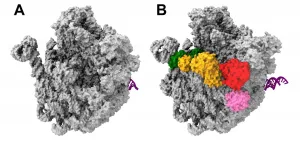
ELSE PRESS RELEASES FROM THIS DATE:
2021-03-01
What can you see on this picture (next to thearticle)? Say what comes to your mind immediately!
If you said „star", you focus rather on the details, if you said „sun", then rather on the global pattern.
People can be different in whether they typically see the forest or the trees, but the dominant attentional mode is focusing first on the whole, and then on the details. This is the same with children. Or so it has been until now! Children of the Alpha Generation (who has been born after 2010) typically grow up with mobile devices in their hands which seems to change how they perceive the world, as Hungarian researchers showed.
The Alpha Generation Lab of Diagnostics and Therapy Excellence Programme at Eötvös Loránd University (Budapest) studies ...
2021-03-01
Materials - Quantum building blocks
Oak Ridge National Laboratory scientists demonstrated that an electron microscope can be used to selectively remove carbon atoms from graphene's atomically thin lattice and stitch transition-metal dopant atoms in their place.
This method could open the door to making quantum building blocks that can interact to produce exotic electronic, magnetic and topological properties.
This is the first precision positioning of transition-metal dopants in graphene. The produced graphene-dopant complexes can exhibit atomic-like behavior, inducing desired properties in the graphene.
"What could ...
2021-03-01
Collaborating with the University of Oxford, Professor Ho Yin Edwin Chan's research team from the School of Life Sciences of The Chinese University of Hong Kong (CUHK) recently unveiled the counteracting relationship between pre-mRNA-processing factor 19 (Prpf19) and exocyst complex component 7 (Exoc7) in controlling the degradation of disease protein and neurodegeneration of the rare hereditary ataxia. The research findings have been published in the prestigious scientific journal, Cell Death & Disease.
Protein misfolding contributes to the pathogenesis of SCA3
Proteins play a significant role in every single cell development in the human body, including neurons. Numerous studies have proved that misfolds and aggregation of ...
2021-03-01
A new paper by Dr. Miki Ben-Dor and Prof. Ran Barkai from the Jacob M. Alkow Department of Archaeology at Tel Aviv University proposes an original unifying explanation for the physiological, behavioral and cultural evolution of the human species, from its first appearance about two million years ago, to the agricultural revolution (around 10,000 BCE). According to the paper, humans developed as hunters of large animals, causing their ultimate extinction. As they adapted to hunting small, swift prey animals, humans developed higher cognitive abilities, evidenced by the most obvious evolutionary change - the growth of brain volume from ...
2021-03-01
A study carried out by researchers from the Institute of Genomics, University of Tartu revealed that human gut microbiome can be used to predict changes in Type 2 diabetes related glucose regulation up to four years ahead.
Type 2 diabetes is a metabolic disease characterized by elevated blood glucose levels that contributes to millions of deaths worldwide each year and its prevalence is rapidly increasing. Type 2 diabetes is preceded by "prediabetes" - a condition when the glucose levels have started to rise, but the progression of the disease ...
2021-03-01
Takeaway coffees - they're a convenient start for millions of people each day, but while the caffeine perks us up, the disposable cups drag us down, with nearly 300 billion ending up in landfill each year.
While most coffee drinkers are happy to make a switch to sustainable practices, new research from the University of South Australia shows that an absence of infrastructure and a general 'throwaway' culture is severely delaying sustainable change.
It's a timely finding, particularly given the new bans on single-use plastics coming into effect in South Australia today, and the likelihood of takeaway coffee cups taking ...
2021-03-01
Tsukuba, Japan - Single-celled algae and animal sperm cells are widely separated in evolution but both swim in the same way, by waving their protruding hairs, called cilia or flagella. Motion is driven by molecular motors, complex assemblies of proteins that exert a force when changing shape. The motor proteins are connected to the cell's internal skeleton of microtubules; the moving force from the motor causes microtubules to slide, moving the flagella and propelling the cell.
Now a team led by Professor Kazuo Inaba of the University of Tsukuba in collaboration with scientists from Osaka University, Tokyo Institute of Technology and Paul Scherrer Institute has described a new protein that is closely ...
2021-03-01
While many people believe misinformation on Facebook and Twitter from time to time, people with lower education or health literacy levels, a tendency to use alternative medicine or a distrust of the health care system are more likely to believe inaccurate medical postings than others, according to research published by the American Psychological Association.
"Inaccurate information is a barrier to good health care because it can discourage people from taking preventive measures to head off illness and make them hesitant to seek care when they get sick," said lead author Laura D. Scherer, PhD, with the University of Colorado School of Medicine. "Identifying who is most susceptible to misinformation ...
2021-03-01
Electric scooters or "e-scooters" are taking over cities worldwide and have broad appeal with tourists. Although e-scooter use declined during the COVID-19 pandemic, its popularity could rebound rapidly, especially if travelers start to substitute scooters for transit on some shorter trips. Shared e-scooters in particular, are a rapidly emerging mode of transportation, but present a host of regulatory challenges from equitable distribution to parking infrastructure to pedestrian safety, among others.
Understanding travel demand patterns of shared ...
2021-03-01
An associate professor from RUDN University found out the effect of the number and size of pores on the permeability of bone implants by biological fluids. The results of the study could help choose the optimal physical parameters of implants. The results of the study were published in the International Journal of Engineering.
For an implant to survive in the body and to take the place of bone tissue, it should be made of a non-toxic, biologically inert, and wearproof material. However, at the same time, it should be light, porous, and permeable by biological liquids. If an implant does not interfere with the transfer of oxygen, minerals, and nutrients, new bone tissue and blood vessels start to grow around it, and a patient's ...
LAST 30 PRESS RELEASES:
[Press-News.org] Searching for novel targets for new antibiotics
Helper protein controls interactive process of ribosome formation


